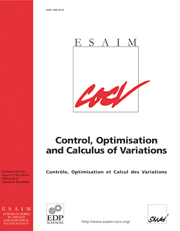Crossref Citations
This article has been cited by the following publications. This list is generated based on data provided by Crossref.
Mitake, H.
and
Tran, H.V.
2014.
A dynamical approach to the large-time behavior of solutions to weakly coupled systems of Hamilton–Jacobi equations.
Journal de Mathématiques Pures et Appliquées,
Vol. 101,
Issue. 1,
p.
76.
Mitake, Hiroyoshi
and
Tran, Hung V.
2014.
Homogenization of Weakly Coupled Systems of Hamilton–Jacobi Equations with Fast Switching Rates.
Archive for Rational Mechanics and Analysis,
Vol. 211,
Issue. 3,
p.
733.
Mitake, Hiroyoshi
and
Tran, Hung V.
2015.
Large-time behavior for obstacle problems for degenerate viscous Hamilton–Jacobi equations.
Calculus of Variations and Partial Differential Equations,
Vol. 54,
Issue. 2,
p.
2039.
Cagnetti, Filippo
Gomes, Diogo
Mitake, Hiroyoshi
and
Tran, Hung V.
2015.
A new method for large time behavior of degenerate viscous Hamilton–Jacobi equations with convex Hamiltonians.
Annales de l'Institut Henri Poincaré C, Analyse non linéaire,
Vol. 32,
Issue. 1,
p.
183.
Gomes, Diogo A.
Pimentel, Edgard A.
and
Sánchez-Morgado, Héctor
2015.
Time-Dependent Mean-Field Games in the Subquadratic Case.
Communications in Partial Differential Equations,
Vol. 40,
Issue. 1,
p.
40.
Aleksanyan, Gohar
2016.
Optimal regularity in the optimal switching problem.
Annales de l'Institut Henri Poincaré C, Analyse non linéaire,
Vol. 33,
Issue. 6,
p.
1455.
Gomes, Diogo A.
and
Patrizi, Stefania
2016.
Weakly coupled mean-field game systems.
Nonlinear Analysis,
Vol. 144,
Issue. ,
p.
110.
Mitake, H.
Siconolfi, A.
Tran, H. V.
and
Yamada, N.
2016.
A Lagrangian Approach to Weakly Coupled Hamilton--Jacobi Systems.
SIAM Journal on Mathematical Analysis,
Vol. 48,
Issue. 2,
p.
821.
Mitake, Hiroyoshi
and
Tran, Hung V.
2017.
Selection problems for a discount degenerate viscous Hamilton–Jacobi equation.
Advances in Mathematics,
Vol. 306,
Issue. ,
p.
684.
Koike, Shigeaki
Kosugi, Takahiro
and
Naito, Makoto
2018.
On the rate of convergence of solutions in free boundary problems via penalization.
Journal of Mathematical Analysis and Applications,
Vol. 457,
Issue. 1,
p.
436.
Festa, Adriano
Gomes, Diogo A.
and
Velho, Roberto M.
2018.
PDE Models for Multi-Agent Phenomena.
Vol. 28,
Issue. ,
p.
73.
Terai, Kengo
2019.
Uniqueness structure of weakly coupled systems of ergodic problems of Hamilton–Jacobi equations.
Nonlinear Differential Equations and Applications NoDEA,
Vol. 26,
Issue. 6,
Ishii, Hitoshi
and
Jin, Liang
2020.
The vanishing discount problem for monotone systems of Hamilton–Jacobi equations: part 2—nonlinear coupling.
Calculus of Variations and Partial Differential Equations,
Vol. 59,
Issue. 4,
Ishii, Hitoshi
2021.
The vanishing discount problem for monotone systems of Hamilton-Jacobi equations. Part 1: linear coupling.
Mathematics in Engineering,
Vol. 3,
Issue. 4,
p.
1.
Dumitrescu, Roxana
Leutscher, Marcos
and
Tankov, Peter
2021.
Control and optimal stopping Mean Field Games: a linear programming approach.
Electronic Journal of Probability,
Vol. 26,
Issue. none,
Klibanov, Michael
Nguyen, Loc H.
and
Tran, Hung V.
2022.
Numerical viscosity solutions to Hamilton-Jacobi equations via a Carleman estimate and the convexification method.
Journal of Computational Physics,
Vol. 451,
Issue. ,
p.
110828.
Sirignano, Justin
MacArt, Jonathan
and
Spiliopoulos, Konstantinos
2023.
PDE-constrained models with neural network terms: Optimization and global convergence.
Journal of Computational Physics,
Vol. 481,
Issue. ,
p.
112016.
Shi, Xiaowen
Zhang, Xiangyu
Tang, Renwu
and
Yang, Juan
2023.
Solve High-Dimensional Reflected Partial Differential Equations by Neural Network Method.
Mathematical and Computational Applications,
Vol. 28,
Issue. 4,
p.
79.
Chiri, Maria Teresa
Czuprynski, Kenneth D
and
Zikatanov, Ludmil T
2024.
Weakly Coupled Systems of Eikonal Equations in Path-Planning Problems.
p.
5036.
Koike, Shigeaki
and
Kosugi, Takahiro
2024.
Mathematical Physics and Its Interactions.
Vol. 451,
Issue. ,
p.
63.


